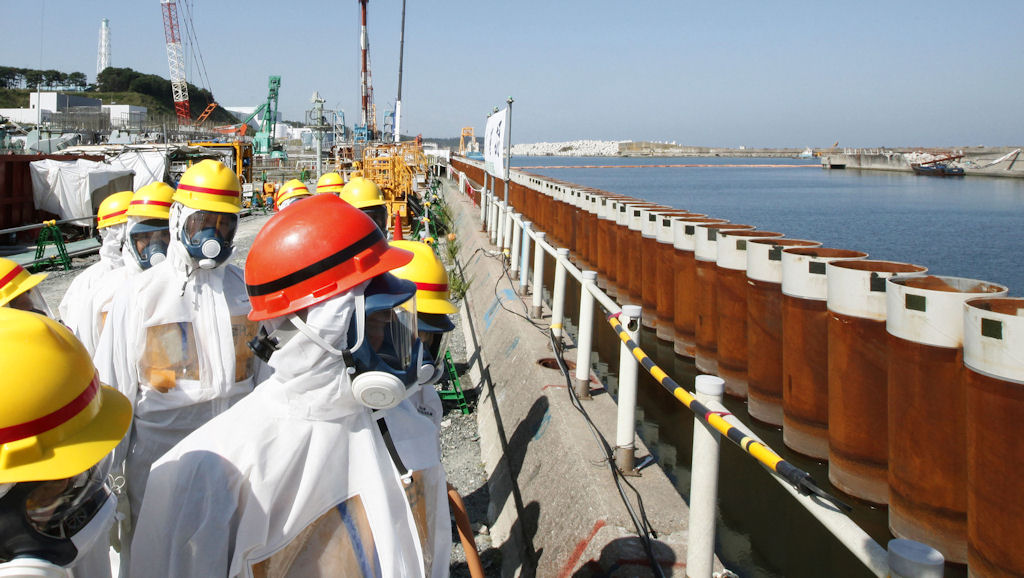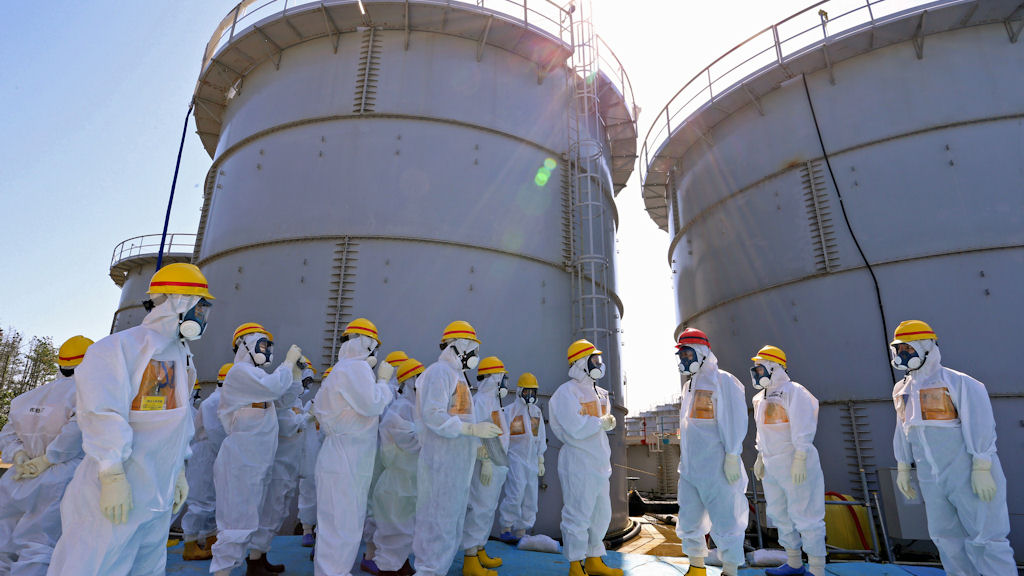Fukushima: why next month is its biggest since 2011
The headlines are alarming: vast leaks of radioactive water, international experts being drafted in and spikes in radiation levels. But how bad is the situation at Japan’s Fukushima nuclear plant?

It looms, forbiddingly now, on the coast of Japan, flanked by the sea, forests and a huge nuclear exclusion zone.
Despite recent attempts to demystify the crippled Fukushima Dai-ichi nuclear plant – Japan’s Prime Minister Shinzo Abe even visited a few weeks ago – the truth behind what’s happening there and what it actually means for locals and the wider world remains difficult to obtain. And there could be worse to come.
In November, Tepco is due to carry out a new operation which could be the most risky since the early dark days of the initial crisis sparked by the March 2011 earthquake and tsunami.
Read more: What is happening at Fukushima?
The World Nuclear Report in 2013 said the operation had the potential to cause “by far the most serious radiological disaster to date” if it goes wrong. It warns of the possibility of apocalyptic scenarios including the evacuation of 10 million people in the surrounding area, including Tokyo.
The process involves moving around 400 tonnes of irradiated spent fuel from reactor 4, one of the four reactors damaged in the 2011 disaster. While the other three reactors went into meltdown and are still being cooled with water after other systems failed, the fourth was not operational at the time. However, it still has spent fuel in it which needs to be removed from the now highly unstable structure in case of any kind of earthquake hitting the plant again.

Removing spent fuel is a normal procedure at a nuclear plant – but not in an environment with so many risks and unknowns, including whether the fuel assemblies have been damaged, which could lead to the radiation risks if the casings have been breached. The worst case scenario is if the fuel assemblies are dropped, which could ultimately lead to a partial meltdown – but that is not thought to be likely.
Professor Neil Hyatt, a nuclear expert at Sheffield University, told Channel 4 News reports have been “very clear on the worst that can happen”, adding: “Is that feasible? Yes. Is it realistic? That’s hard to say. This is probably a world first in terms of the engineering challenge.”
A Tepco spokeswoman added: “The removal of the fuels is an experienced technology used everywhere over the world. The risks are evaluated and well under control.”
But it’s not the only challenge at Fukushima. Professor Hyatt points out that nobody is talking about the fuel still in the other three reactors, which are partially melted down and still require constant cooling.
This is probably a world first in terms of the engineering challenge. Professor Neil Hyatt, Sheffield University
“We don’t understand fully what the nature of the partially melted down core is. That’s ultimately a challenge we’ll need to address,” he said. Tepco said its plans are to begin removing this debris within eight years – aiming for complete decommissioning within 40 years.
Mycle Schneider is the co-author of the World Nuclear Report which warned of such potentially dire consequences of November’s operation.
He was no less gloomy when Channel 4 News spoke to him – although that’s fairly predictable as after years advising the French and German governments, as an independent consultant he now has a reputation for being anti-nuclear.
“To me it’s been disastrous from day one. This disaster is of totally unprecedented dimensions,” he said. “Tepco is a company that manages electricity generation plants, whether this is hydro or coal or nuclear. It is by no means a clean-up, disaster management, assembly of supermen that could deal spontaneously with issues like that.”
Tepco itself has recognised this – some would argue belatedly – and turned to international experts for long-term help, although a Tepco spokeswoman reassured this programme that the company had been “asking for help from countries with decontamination experiences since the accident”. Dr Adrian Simper of the UK Nuclear Decommissioning Authority recently chaired a trip of the group to Fukushima.
He told Channel 4 News: “It’s about getting in control of things like the groundwater, the day-to-day issues, so we can concentrate on fighting the alligators and not worry about constantly draining the swamps.”
Alligators and swamps
The situation in and around Fukushima plant today is mixed. There is still a deserted 20km exclusion zone beyond the plant as well as contaminated debris stored on the plant. However, the reactors are relatively stable, or as much as they can be in the current state, and the Japanese government recently said radiation in the air in the surrounding area has declined by 40 per cent – although it spikes regularly within the power station. It is worth pointing out that the situation felt rather more patchy than that when Channel 4 News visited this summer.
However, the main problem at Fukushima at the moment, as Dr Simper referred to, is the leaking water, and what that might be doing to the sea beyond.
The water is leaking from two key places. Firstly, the water which is being pumped into the reactors to keep them cool. This gets contaminated by the radioactive fuel inside the reactors, and has to be stored on site in huge – leaky – tanks. There’s a second problem too. Groundwater which runs off the hills nearby used to be removed from the site by pumps, but these stopped working in the tsunami. The basements of the reactor buildings flooded. Now this water is also contaminated with radioactivity – and leaking into the ground, and the sea, beyond.
Tepco told Channel 4 News it estimates that around 400 tonnes are leaking every day – although it says the results are “almost non-detectable levels” of radiation “so there are no effects to the health.”

Ken Buesseler, senior scientist at the Woods Hole Oceanographic Institution in the United States, has been looking at what this actually means. He is blunt in his assessment.
“It seems Tepco has been unable to adequately manage the clean-up and public understanding of the risks,” he told Channel 4 News. “My trip in September reinforced the very simple fact that we do see Fukushima Cs isotopes elevated in the ocean near the reactor site, which indicates leakage from the reactors and tanks.
It seems Tepco has been unable to adequately manage the clean-up and public understanding of the risks. Ken Buesseler
“You can argue about how much leakage or what are the impacts, but it is certain that radionuclides from the power plant site are entering the ocean and have been since March 2011.”
At the same time, Mr Buesseler and others agree that, for now, the leaks are not affecting human health or fish stocks any further afield than just off the Japanese coast. As National Geographic put it, the Pacific Ocean is a big place and recent leaks of 300 gallons here and there pale into insignificance compared with the ocean’s total volume.
Fishing is still banned off the coast of Fukushima, but earlier this year, surfers cheerfully posed for photos at Toyoma Beach, around 50 kilometres south of the broken plant. So Mr Buesseler isn’t the only one playing down the risks.
And Dr Simper goes further – perhaps further than many could countenance at this point, although it will be a bit of good news for Tepco in a sea of criticism which has been easily as toxic as anything the plant has leaked.
“People will absolutely be able to come back and live here,” he told Channel 4 News.
“In fact, I believe people should be able to return now. I would have no hesitation in moving my family to Fukushima…it’s a lovely part of the world.”
Dr Adrian Simper would take his family to live near the Fukushima nuclear plant – but what is it actually like living and working in the area? In the final instalment of our Fukushima series, coming up later this week, Channel 4 News speaks to locals to find out.